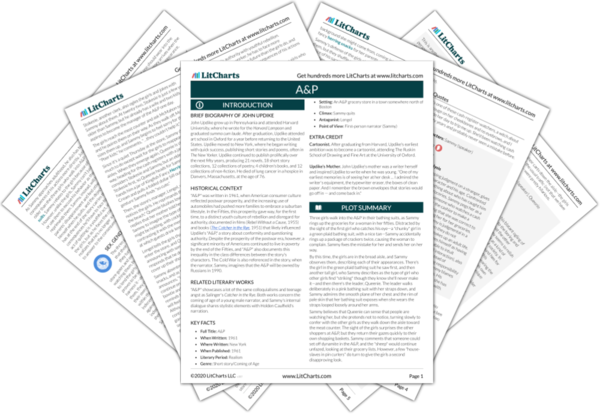Welcome to the LitCharts study guide on John Updike's A&P. Created by the original team behind SparkNotes, LitCharts are the world's best literature guides.
A&P: Introduction
A concise biography of John Updike plus historical and literary context for A&P.
A&P: Plot Summary
A quick-reference summary: A&P on a single page.
A&P: Detailed Summary & Analysis
In-depth summary and analysis of every section of A&P. Visual theme-tracking, too.
A&P: Themes
Explanations, analysis, and visualizations of A&P's themes.
A&P: Quotes
A&P's important quotes, sortable by theme, character, or section.
A&P: Characters
Description, analysis, and timelines for A&P's characters.
A&P: Symbols
Explanations of A&P's symbols, and tracking of where they appear.
A&P: Theme Wheel
An interactive data visualization of A&P's plot and themes.
Brief Biography of John Updike
John Updike grew up in Pennsylvania and attended Harvard University, where he wrote for the Harvard Lampoon and graduated summa cum laude. After graduation, Updike attended art school in Oxford for a year before returning to the United States. Updike moved to New York, where he began writing with quick success, publishing short stories and poems, often in The New Yorker. Updike continued to publish prolifically over the next fifty years, producing 21 novels, 18 short story collections, 12 collections of poetry, 4 children's books, and 12 collections of non-fiction. He died of lung cancer in a hospice in Danvers, Massachusetts, at the age of 76.
Get the entire A&P LitChart as a printable PDF.

Historical Context of A&P
"A&P" was written in 1961, when American consumer culture reflected postwar prosperity, and the increasing use of automobiles had pushed more families to embrace a suburban lifestyle. In the Fifties, this prosperity gave way, for the first time, to a distinct youth culture of rebellion and disregard for authority, documented in films (Rebel Without a Cause, 1955) and books (The Catcher in the Rye, 1951) that likely influenced Updike's "A&P," a story about conformity and questioning authority. Despite the prosperity of the postwar era, however, a significant minority of Americans continued to live in poverty by the end of the Fifties, and "A&P" also documents this inequality in the class differences between the story's characters. The Cold War is also referenced in the story, when the narrator, Sammy, imagines that the A&P will be owned by Russians in 1990.
Other Books Related to A&P
"A&P" showcases a lot of the same colloquialisms and teenage angst as Salinger's Catcher in the Rye. Both works concern the coming of age of a young male narrator, and Sammy's internal dialogue shares stylistic elements with Holden Caulfield's narration.
Key Facts about A&P
- Full Title: A&P
- When Written: 1961
- Where Written: New York
- When Published: 1961
- Literary Period: Realism
- Genre: Short story/Coming of Age
- Setting: An A&P grocery store in a town somewhere north of Boston
- Climax: Sammy quits
- Antagonist: Lengel
- Point of View: First-person narrator (Sammy)
Extra Credit for A&P
Cartoonist. After graduating from Harvard, Updike's earliest ambition was to become a cartoonist, attending The Ruskin School of Drawing and Fine Art at the University of Oxford.
Updike's Mother. John Updike's mother was a writer herself and inspired Updike to write when he was young. "One of my earliest memories is of seeing her at her desk ... I admired the writer's equipment, the typewriter eraser, the boxes of clean paper. And I remember the brown envelopes that stories would go off in — and come back in."












